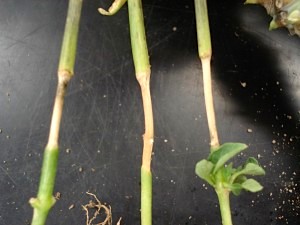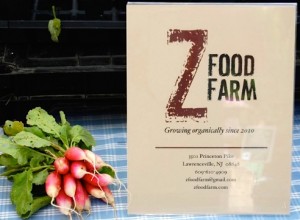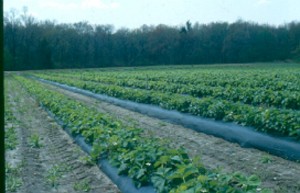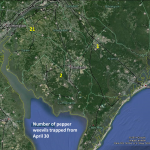Vegetable IPM Report 5-14-14 – Click to View | Download | Print
Maps for the Week
–Pepper Weevil Trap Catch Map
–European Corn Borer Population MapTopics for the Week
- Sweet Corn
- Cole Crops
- BMSB
- Pepper Weevil Update
Vegetable Crops Edition
Seasonal updates and alerts on insects, diseases, and weeds impacting vegetable crops. New Jersey Commercial Vegetable Production Recommendations updates between annual publication issues are included.
Subscriptions are available via EMAIL and RSS.
Quick Links:
 NJ Commercial Vegetable Production Recommendations
NJ Commercial Vegetable Production Recommendations
 Rutgers Weather Forecasting - Meteorological Information important to commercial agriculture.
Rutgers Weather Forecasting - Meteorological Information important to commercial agriculture.
Veg IPM Update: Week Ending 5/14/14
Sunscald Injury in Transplants
Now that the weather is beginning to cooperate and temperatures are warming up, be cautious about sunscald developing on the stems of transplants, especially those being set onto black plastic mulch. With a little planning ahead potential losses to sunscald injury can reduced significantly.

Sunscald injury on stems of newly transplanted pepper seedlings caused by stems laying against edges of black plastic mulch on hot, sunny days.
Sunscald typically appears as the slow bleaching out of the stem that will typically appear only on one side. Often this starts to appear right where the stem meets the black plastic mulch. In many cases if the stem is touching the mulch, the sunburn will start there and the transplant will begin to fall over as if the stem was broken.
When transplanting, make sure the holes in the plastic are wide enough to keep the stem from coming into contact with it. In some cases growers will fill in the transplant hole with soil to help keep the transplant upright before between-row herbicides are applied. ‘Leggy’ transplants that lay across plastic mulch and even those transplanted onto bare ground are prone to sunscald injury.
Small Farm Post-Harvest Practices Workshop
Date: Tuesday, May 20, 2 PM to 4:30 PM
Location: Webinar presentation @ Rutgers Cooperative Extension Office of Mercer County, 930 Spruce Street, Trenton, NJ
Followed by on-farm portion @ Z Food Farm, 3501 Princeton Pike, Lawrence, NJ
Improving post-harvest practices can help minimize produce damage and maximize the amount of quality produce that can be sold at market. Evaluating current post-harvest practices and identifying low-cost improvements is an important part of farm planning, and should be done as early in the season as possible.
 Rutgers Cooperative Extension of Mercer County and NOFA-NJ welcome Lee Stivers from Penn State Extension as she joins us remotely giving a presentation on post-harvest handling procedures for high-quality, marketable produce via webinar.
Rutgers Cooperative Extension of Mercer County and NOFA-NJ welcome Lee Stivers from Penn State Extension as she joins us remotely giving a presentation on post-harvest handling procedures for high-quality, marketable produce via webinar.
The webinar workshop portion will be followed by a farm tour of Z Food Farm’s post-harvest handling set-up. Z Food Farm is a small certified organic farm located in Lawrenceville, NJ.
[Read more…]
Weed Control in Re-Used Plastic Mulch

Plastic mulch and trickle irrigation are expensive.
Re-using the mulch for a second crop after the first can be an effective way to spread the cost.
[Read more…]
Veg IPM Update: Week Ending 5/07/14
 Vegetable IPM Report 5-07-14 – Click to View | Download | Print
Vegetable IPM Report 5-07-14 – Click to View | Download | Print
Current Week’s Pest Maps – Available Maps for the week
Pepper Weevil Trap Catch Map
Rutgers Cooperative Extension IPM personnel are currently deploying blacklight trap and insect pheromone trap networks throughout the state. Statewide sampling will commence shortly, and as soon as target pests begin to appear, insect data will be published in the Plant and Pest Advisory and on the NJAES website @ http://tinyurl.com/njaes-ipm-maps
Pest populations of European corn borer (ECB), corn earworm (CEW) and brown marmorated stink bug (BMSB) from blacklight samples will be posted in table and in map format. Additionally, adult CEW populations from a pheromone network in southern NJ will be posted in both formats. Pepper weevil trap catches from southern NJ will be posted in map format. Beet armyworm (BAW) adult populations from a southern NJ pheromone network will be posted in table form beginning in mid-July.
Understanding Combination Insecticide Products
When using blended products:
- Know the pest that you need to control.
- Use an appropriate insecticide that will do the job with as little negative impact as possible.
- Avoid broad spectrum insecticides when possible.
- Avoid using redundant materials.
Over the past decade, the number of vegetable insecticides (both commercial products and insecticide classes) has increased significantly. Included in these are a number of materials with novel modes of action (MOA), and high degrees of pest specificity. For example, some newer materials have efficacy against caterpillars only, while others may control caterpillars and some fly larvae. Other examples are detailed in the chart, Combination Insecticide Products for Commercial Vegetable Crops. This article clarifies the options in the Commercial Vegetable Recommendations so that growers may make more informed choices as to the most useful product for specific pests. [Read more…]
